High Command: Castle of the Keys Campaign Expansion – Winds of War and Location Decks

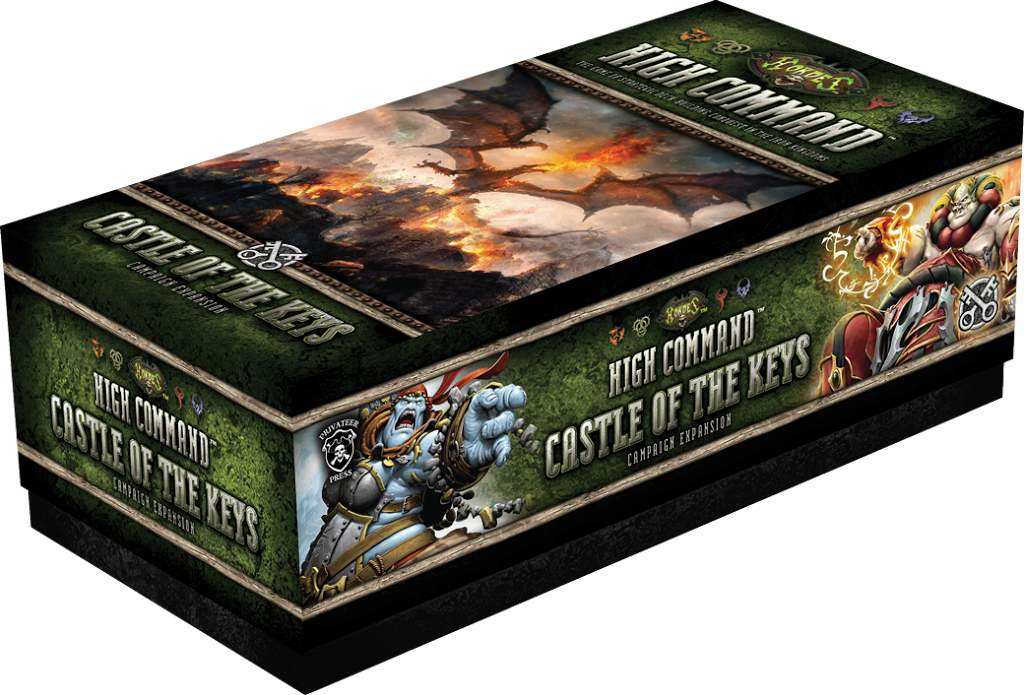 |
| Courtesy of Privateer Press Digital. Used with Permission. |
The Castle of the Keys campaign expansion to Hordes: High Command, bringing with it exciting and treacherous Winds of War and Location cards.
Anyone who has been playing High Command since its initial release knows full well how much of an impact the Invasion of Sul campaign expansion had on the game, not simply for its new faction cards, but because of the effect that it had on how you play the game and prepare your detachments as well. The Winds of War and Location decks in Invasion of Sul were markedly more interactive than in the core sets and required far more planning and forethought. Castle of the Keys continues this trend with its offering, creating even more potential game play variety than before.
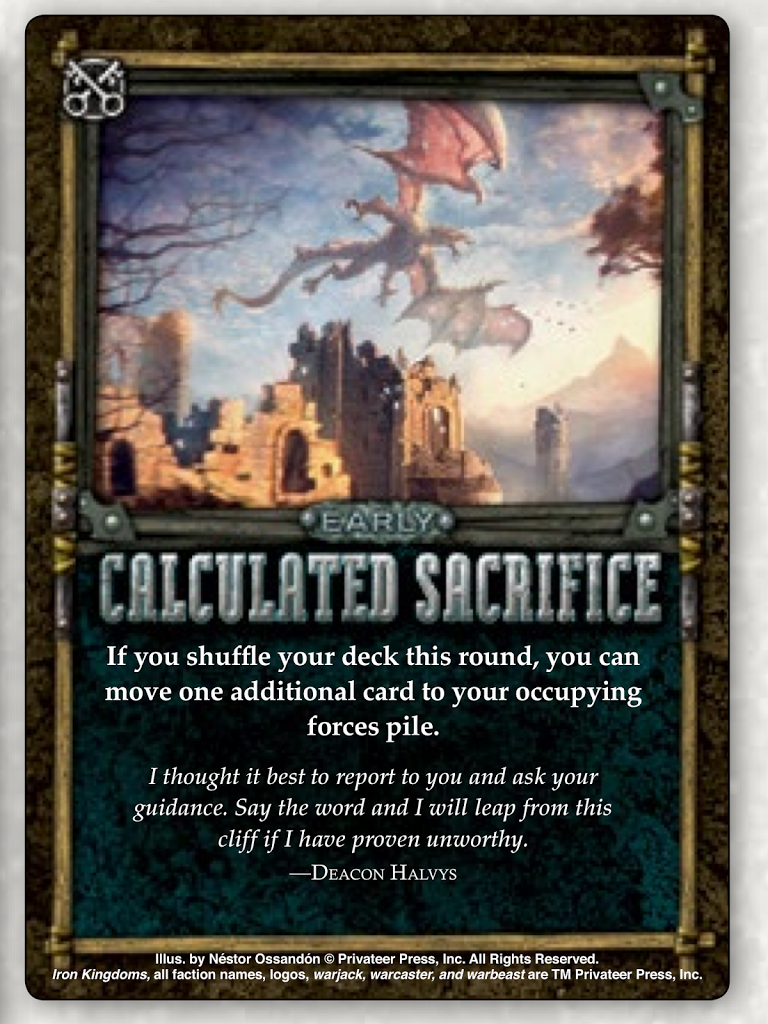 |
| Courtesy of Privateer Press Digital. Used with Permission. |
The final card from the Early deck is Calculated Sacrifice. This is a really interesting card that has some potential to not come into play, particularly if it is drawn on the first turn when shuffling cannot happen. If you do manage to draw Calculated Sacrifice late in the Early phase, it can be a fantastic tool for getting rid of cards with rather weak purchasing power, like Bane Riders or those lackluster 1/1 resource cards. There is one copy of Calculated Sacrifice in the Early deck.
Winds of War, Mid –
The first card from the Mid deck is also the last card from Early, Calculated Sacrfice. While this card has the possibility of being of no use to either player if drawn on turn one, this obviously cannot be a problem during the Mid phase. Strangely, in order to assure that you get use out of this card when drawn, you will want to do your best to keep your deck thin so that you can increase your chances of requiring a shuffle, perhaps suggesting that Castle of the Keys may promote sending more cards to occupying forces than you might otherwise. There is one copy of Calculated Sacrifice in the Mid deck.
The second card from the Mid deck is Redirection, which denies the rushing of warbeast, warjack, or warrior cards for the round. This card can throw a real wrench in the works for aggressive Circle, Legion, or Cryx decks that are extremely rush-heavy, so players of those factions beware. Since these types of decks seem to be dominating the metagame at the moment, I am happy to see Redirection in this expansion, particularly since Castle lacks a location card like Narrow Streets. There is one copy of Redirection in the Mid deck.
The third card in the Mid deck is Isolated Forces, which states that if one of your cards is the only friendly card at a location, it suffers -2 Power. This is another interesting card since it seems to promote a more balanced approach to deck builds in lieu of the strong, expensive value cards that are all-too-common in the game today, potentially making some of those cheaper options that might otherwise be avoided due to lack of Victory Points more attractive. This card makes me an even bigger fan of the Trencher Commandos, as their low Power value is of no consequence in the case of Isolated Forces thanks to their Assassinate rule. There is one copy of Isolated Forces in the Mid deck.
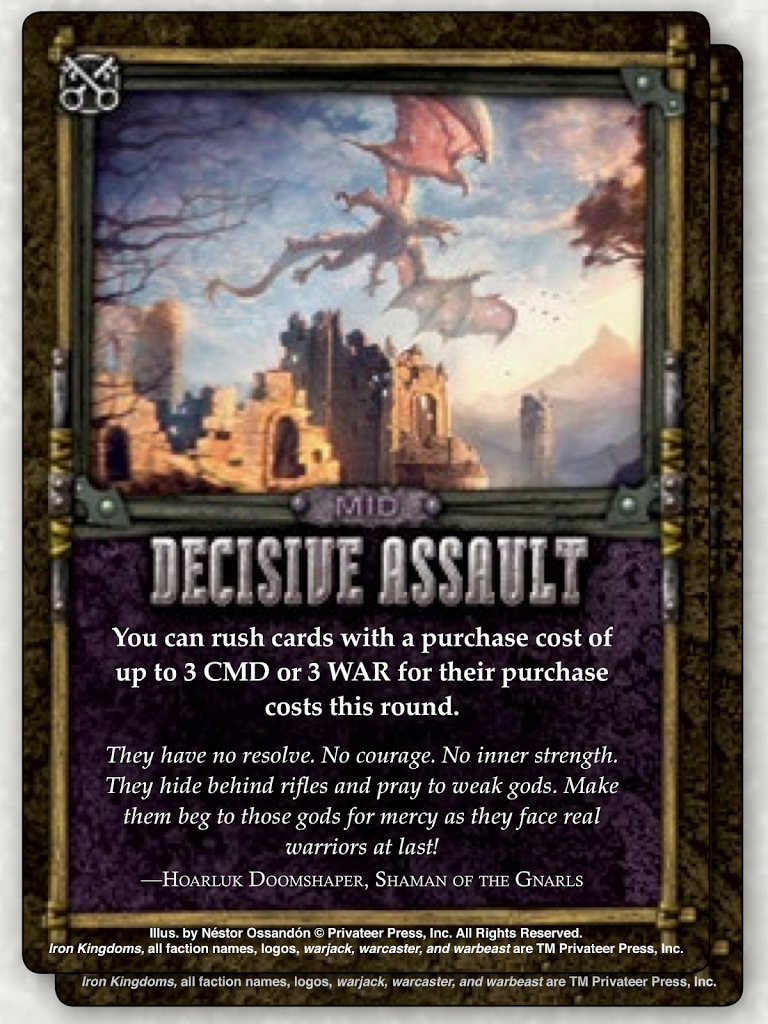 |
| Courtesy of Privateer Press Digital. Used with Permission. |
The final card for the Mid deck is Decisive Assault. Like Isolated Forces, this card is another card that favors those cards with cheap purchase costs, typically those without a Victory Point value. When taking advantage of Decisive Assault, you will ideally want to look for cards with low purchase costs and lousy rush margins like the Revenant Cannon Crews or the new Retribution Soulless that are 1 to-purchase and 8 to-rush. There are two copies of Decisive Assault in the Mid deck.
Winds of War, Late –
Two of the cards in the Late deck are copies of cards found in the Mid game, specifically Redirection and Isolated Forces. While Isolated Forces will not likely be more impacting in the Late phase, Redirection certainly will be, particularly for decks with a large volume of 4/4 and 3/3 resource cards that are looking to make big rushes before Day of Reckoning is flipped. There is one copy of each of these cards in the Late deck.
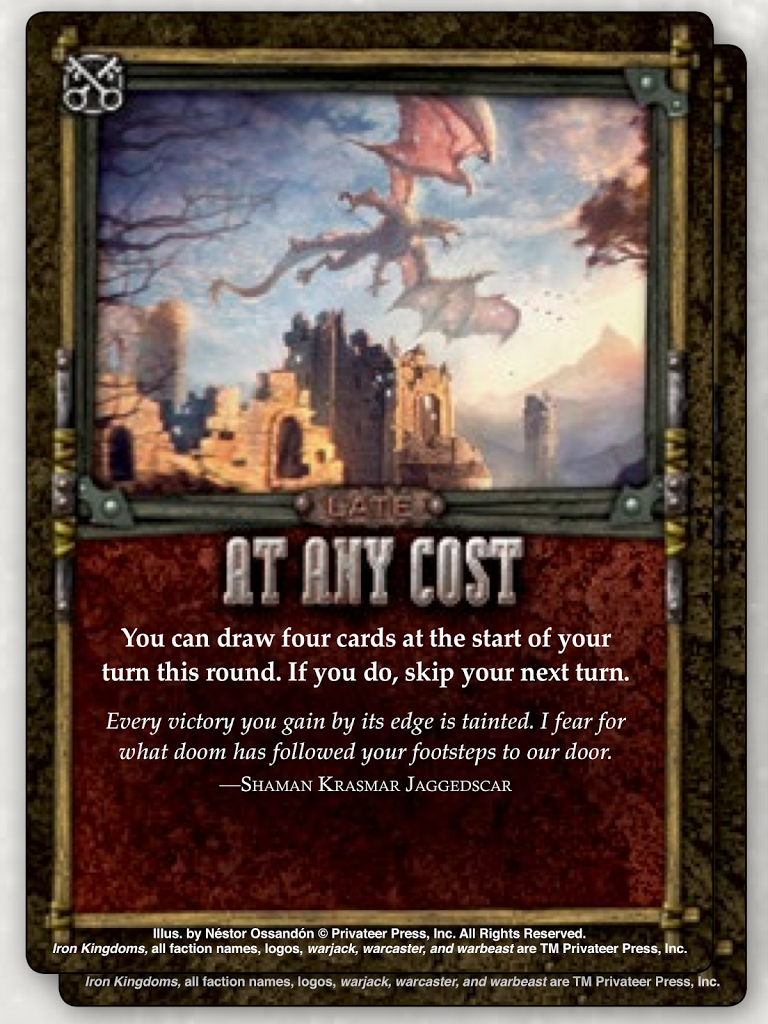 |
| Courtesy of Privateer Press Digital. Used with Permission. |
At Any Cost represents a huge risk as a Late phase card. If the next card flipped over is Day of Reckoning, the gambit of taking advantage of this card will likely pay off large dividends. If Day of Reckoning is not flipped, you will have a net loss of two drawn cards while also being unable to respond properly to any new rushes or deployments. Consequently, if At Any Cost is drawn early in the Late phase, it may be a good idea to let it go unless you really need an immediate boost to hold onto a lead or stop your opponent from running away with one. If it is turn 14, however, there is absolutely no reason at all not to take advantage, so keep an eye on how many cards are left in the Winds of War deck and respond appropriately. There are two copies of At Any Cost in the Late deck.
The final card in the Late deck is naturally Day of Reckoning, which ends the game and allows immediate captures for all players as if it were the beginning of their turn. This is the same card found in Invasion of Sul as well as the Hordes and Warmachine core sets, so there really is not much to say about that has not already been stated. Once you are in the late game, you should be playing aggressively and looking for the last-second captures if at all possible.
Locations –
We will be looking at the Location deck in a much more general sense, since it seems to, as a whole, promote a singular theme in detachment builds. Many of the cards in the location deck seem to favor running a large volume of cards at any one location, like Pyromalfic, which destroys one of your friendly cards at its location at the start of your turn, Perilous Ruins, which requires that you keep at least two cards present else a loan card is destroyed, Blighted Passage, which requires that one of your cards loses its ability, and Escape Tunnel, which allows you to return destroyed cards at another location to your hand provided you have more cards at Escape Tunnel than your opponents. Crumbling Parapet seems to specifically suggest that you run cards with base Health values lower than 5, although it can be used to move high-value cards back to your hand after an attack is made so those cards don’t get moved to occupying forces.
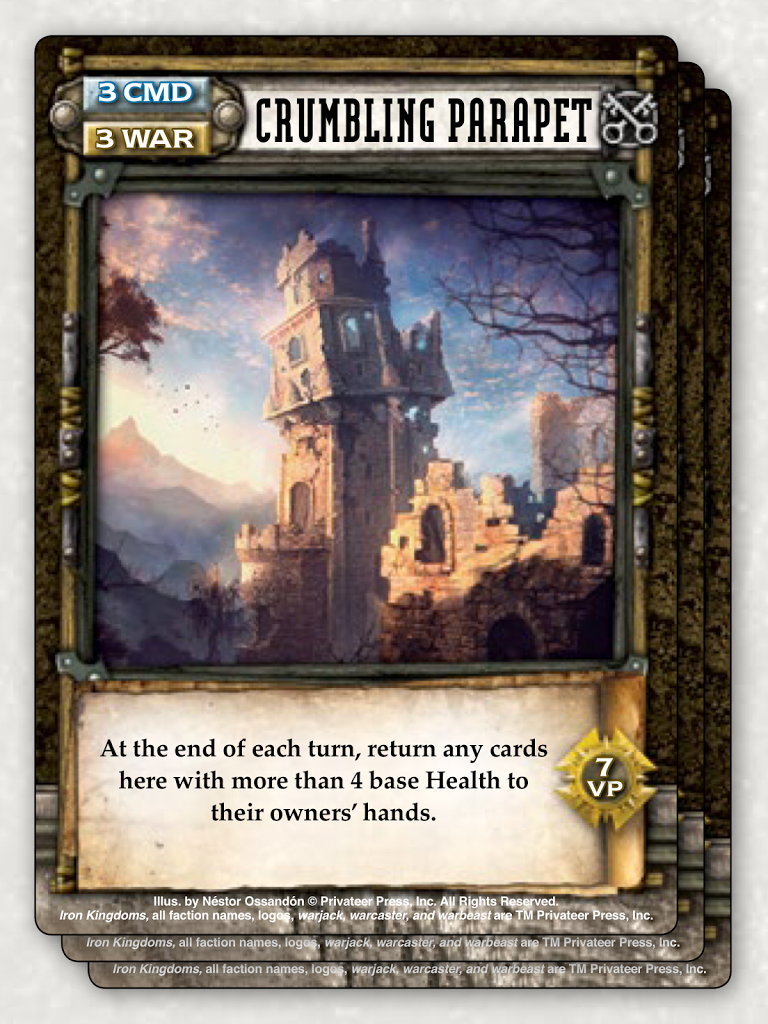 |
| Courtesy of Privateer Press Digital. Used with Permission. |
The resource values in the Location deck are generally on the lower side, with Crumbling Parapet being the highest producer at 3 CMD/3 WAR. Escape Tunnel and Pyromalfic are extremely low in their resource production and will likely warrant exile into occupying forces at the first opportunity.
Cliffside Vantage Point and Caverns of Inscriptions are fairly interesting and stand out a bit from the rest of the crowd. Cliffside Vantage Point allows you to refresh one card in your reserves whenever you rush or deploy a card to it, while Caverns of Inscriptions reduces the rush cost of a card being moved to it by 2 CMD or 2 WAR to a minimum of the card’s purchase cost.
In terms of Victory Points, general value is pretty high across the board, generally in the 5-to-8 realms, so aggressive play will be rewarded for capture-centric strategies. The unprecedented 13 VP awarded for capturing Pyromalfic will likely make it a hotly-contested location as well.
Overview –
All-in-all, I think that the Location and Winds of War decks are a fantastic addition to the game. Like Invasion of Sul they require a large amount of strategy and even seem to reward builds focused on playing to how these cards interact with your deck. However, Castle of the Keys is not simply a Hordes rehashing of the previous campaign expansion; it is a great complement to it as well, requiring players to not only be aware of what is coming, but of how to exploit it.
This looks like the last of Hordes expansions for at least a few months. Stay tuned as we start looking at the new core set, Faith and Fortune in the next few weeks.




